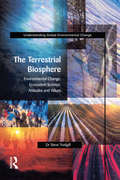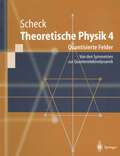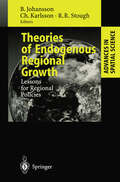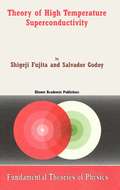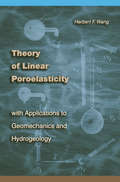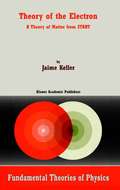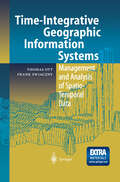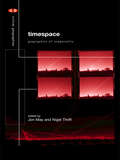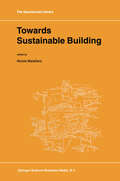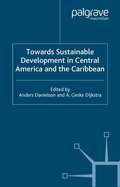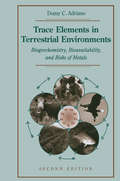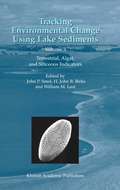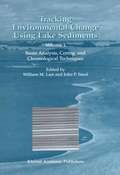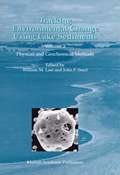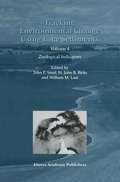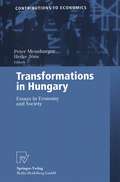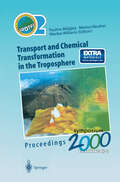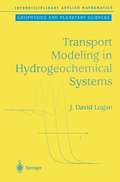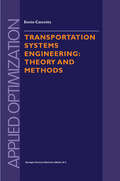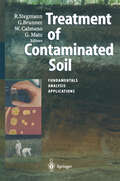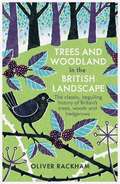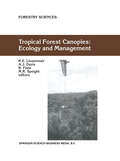- Table View
- List View
The Terrestrial Biosphere: Environmental Change, Ecosystem Science, Attitudes and Values
by Steve TrudgillTerrestrial Biosphere tries to pose the questions which underlie the many-sided debate of how to respond to and influence change: How should we view nature? What do we do for the best - how should we act - what are we trying to achieve and what should we be guided by?In doing so the book introduces and attempts to analyse not only scientific aspects of the debate but also cultural attitudes and values: the notions of ecosystem stability are now challenged and it is also clear that ecosystems are renewable but not repeatable. It finds that prescriptive 'solutions' based on current constructs may not be adequate. Feeling that analysis should lead to advocacy, the author believes that if we can't improve predictability, we have to increase adaptability which means that ecological and social capacity building should be advocated. This is seen in terms of concepts, institutions, attitudes and values which allow for a plurality of meanings and which can cope with surprise and unforeseen change - and which also facilitates responses to change.
The Terrestrial Biosphere: Environmental Change, Ecosystem Science, Attitudes and Values
by Steve TrudgillTerrestrial Biosphere tries to pose the questions which underlie the many-sided debate of how to respond to and influence change: How should we view nature? What do we do for the best - how should we act - what are we trying to achieve and what should we be guided by?In doing so the book introduces and attempts to analyse not only scientific aspects of the debate but also cultural attitudes and values: the notions of ecosystem stability are now challenged and it is also clear that ecosystems are renewable but not repeatable. It finds that prescriptive 'solutions' based on current constructs may not be adequate. Feeling that analysis should lead to advocacy, the author believes that if we can't improve predictability, we have to increase adaptability which means that ecological and social capacity building should be advocated. This is seen in terms of concepts, institutions, attitudes and values which allow for a plurality of meanings and which can cope with surprise and unforeseen change - and which also facilitates responses to change.
Theoretische Physik 4: Quantisierte Felder. Von den Symmetrien zur Quantenelektrodynamik (Springer-Lehrbuch)
by Florian ScheckBewährt – die fünf Bände zur Theoretischen Physik von Prof. Scheck. In Band 4 beginnt er mit einer vertieften Analyse von Symmetrien in der Quantenphysik. Er behandelt u.a. Quantenfeldtheorie von skalaren Feldern, Eichbosonen und Fermionen - überwiegend in kanonischer Quantisierung - und ihre Anwendungen auf wichtige elektromagnetische und schwache Prozesse. Neu in der 2. Auflage sind zwei Abschnitte über die Pfadintegralmethode. Plus: viele ausgearbeitete Beispiele und Übungsaufgaben mit Lösungen oder Hinweisen. Das Buch schließt mit Lebensdaten und historischen Anmerkungen zu einigen der Begründer der Quantenmechanik und -feldtheorie.
Theories of Endogenous Regional Growth: Lessons for Regional Policies (Advances in Spatial Science)
by Börje Johansson Charlie Karlsson Roger R. StoughDuring the last two decades a new growth theory has emerged - often labelled "endogenous economic growth". The contributions in the book develop these advances into a theoretical framework for endogenous regional economic growth and explain the implications for regional economic policies in the perspective of the new century. Endogenous growth models can reflect increasing returns and hence refer more adequately to empirical observations than earlier models, and the models become policy relevant, because in endogenous growth models policy matters. Such policies comprise efforts to stimulate the growth of knowledge intensity of the labour supply and knowledge production in the form of R&D.
Theory of High Temperature Superconductivity (Fundamental Theories of Physics #121)
by S. Fujita S. GodoyFlux quantization experiments indicate that the carriers, Cooper pairs (pairons), in the supercurrent have charge magnitude 2e, and that they move independently. Josephson interference in a Superconducting Quantum Int- ference Device (SQUID) shows that the centers of masses (CM) of pairons move as bosons with a linear dispersion relation. Based on this evidence we develop a theory of superconductivity in conventional and mate- als from a unified point of view. Following Bardeen, Cooper and Schrieffer (BCS) we regard the phonon exchange attraction as the cause of superc- ductivity. For cuprate superconductors, however, we take account of both optical- and acoustic-phonon exchange. BCS started with a Hamiltonian containing “electron” and “hole” kinetic energies and a pairing interaction with the phonon variables eliminated. These “electrons” and “holes” were introduced formally in terms of a free-electron model, which we consider unsatisfactory. We define “electrons” and “holes” in terms of the cur- tures of the Fermi surface. “Electrons” (1) and “holes” (2) are different and so they are assigned with different effective masses: Blatt, Schafroth and Butler proposed to explain superconductivity in terms of a Bose-Einstein Condensation (BEC) of electron pairs, each having mass M and a size. The system of free massive bosons, having a quadratic dispersion relation: and moving in three dimensions (3D) undergoes a BEC transition at where is the pair density.
Theory of Linear Poroelasticity with Applications to Geomechanics and Hydrogeology
by Herbert F. WangThe theory of linear poroelasticity describes the interaction between mechanical effects and adding or removing fluid from rock. It is critical to the study of such geological phenomena as earthquakes and landslides and is important for numerous engineering projects, including dams, groundwater withdrawal, and petroleum extraction. Now an advanced text synthesizes in one place, with one notation, numerous classical solutions and applications of this highly useful theory. The introductory chapter recounts parallel developments in geomechanics, hydrogeology, and reservoir engineering that are unified by the tenets of poroelasticity. Next, the theory's constitutive and governing equations and their associated material parameters are described. These equations are then specialized for different simplifying geometries: unbounded problem domains, uniaxial strain, plane strain, radial symmetry, and axisymmetry. Example problems from geomechanics, hydrogeology, and petroleum engineering are incorporated throughout to illustrate poroelastic behavior and solution methods for a wide variety of real-world scenarios. The final chapter provides outlines for finite-element and boundary-element formulations of the field's governing equations. Whether read as a course of study or consulted as a reference by researchers and professionals, this volume's user-friendly presentation makes accessible one of geophysics' most important subjects and will do much to reduce poroelasticity's reputation as difficult to master.
Theory of the Electron: A Theory of Matter from START (Fundamental Theories of Physics #115)
by J. KellerIn the first century after its discovery, the electron has come to be a fundamental element in the analysis of physical aspects of nature. This book is devoted to the construction of a deductive theory of the electron, starting from first principles and using a simple mathematical tool, geometric analysis. Its purpose is to present a comprehensive theory of the electron to the point where a connection can be made with the main approaches to the study of the electron in physics. The introduction describes the methodology. Chapter 2 presents the concept of space-time-action relativity theory and in chapter 3 the mathematical structures describing action are analyzed. Chapters 4, 5, and 6 deal with the theory of the electron in a series of aspects where the geometrical analysis is more relevant. Finally in chapter 7 the form of geometrical analysis used in the book is presented to elucidate the broad range of topics which are covered and the range of mathematical structures which are implicitly or explicitly included. The book is directed to two different audiences of graduate students and research scientists: primarily to theoretical physicists in the field of electron physics as well as those in the more general field of quantum mechanics, elementary particle physics, and general relativity; secondly, to mathematicians in the field of geometric analysis.
Time-Integrative Geographic Information Systems: Management and Analysis of Spatio-Temporal Data
by Thomas Ott Frank SwiacznyTimeless Simplicity: Creative Living in a Consumer Society
by John LaneA delightful book, celebrating the wonders of simplicity and minimalism in a noisy, overwhelming world.Our planet was once teeming with all kinds of life, but our grandchildren will inherit one with less than 20 per cent of its early forests still in tact, and thousands of plant and animal species extinct. Sooner or later, a more frugal lifestyle is not only desirable, but will soon be imperative. Life at the moment isn't what it should be – technological and economic progress has resulted in a delusion that material solutions will solve emotional problems, but a simpler lifestyle leaves space for spiritual renewal.This is a book about simplicity – not destitution, parsimoniousness or self-denial, but the restoration of wealth in the midst of an affluence in which we are starving the spirit. There are many advantages to living a less cluttered, less stressful life than that which has become the norm in the overcrowded and manic-paced consuming nations. Written by painter, writer and educator John Lane, Timeless Simplicity is an ode to having less and enjoying more. More time to pursue creativity, eat good food, relax with your family – and to just be yourself!
Timespace: Geographies of Temporality (Critical Geographies)
by Jon May Nigel ThriftTimespace undermines the old certainties of time and space by arguing that these dimensions do not exist singly, but only as a hybrid process term. The issue of space has perhaps been over-emphasised and it is essential that processes of everyday existence, such as globalisation and environmental issues and also notions such as gender, race and ethnicity, are looked at with a balanced time-space analysis.The social and cultural consequences of this move are traced through a series of studies which deploy different perspectives - structural, phenomenological and even Buddhist - in order to make things meet up. The contributors provide an overview of the history of time and introduce the concepts of time and space together, across a range of disciplines. The themes discussed are of importance for cultural geography, sociology, anthropology, cultural and media studies, and psychology.
Timespace: Geographies of Temporality (Critical Geographies)
by Jon May Nigel ThriftTimespace undermines the old certainties of time and space by arguing that these dimensions do not exist singly, but only as a hybrid process term. The issue of space has perhaps been over-emphasised and it is essential that processes of everyday existence, such as globalisation and environmental issues and also notions such as gender, race and ethnicity, are looked at with a balanced time-space analysis.The social and cultural consequences of this move are traced through a series of studies which deploy different perspectives - structural, phenomenological and even Buddhist - in order to make things meet up. The contributors provide an overview of the history of time and introduce the concepts of time and space together, across a range of disciplines. The themes discussed are of importance for cultural geography, sociology, anthropology, cultural and media studies, and psychology.
Towards Sustainable Building (GeoJournal Library #61)
by NicolaMaiellaroThis volume contains the extended versions of selected papers presented at the first Mediterranean Conference "Sharing Knowledge on Sustainable Building" held at the Polytechnic ofBari in December 1999, supported by the National Research Council of Italy. The publication of this book was made possible through the efforts of the contributing Authors. Other people have provided invaluable support for the conference and for the preparation of this volume; in particular, I wish to thank Antonella Lerario for providing support in the final editing of the text and images. 1 As reported in Boonstra and Rovers (200 I) , people spend a great deal of time inside buildings; therefore, decisions about design, construction, use, maintenance, renovation, demolition, reuse and recycling of buildings have a huge impact on the sustainable development of our society. Technical aspects, however, should be supported by adequate policies, developed with appropriate tools and driven by meaningful challenges. For people involved in sustainable buildings, the conceptual frameworks, studies and experiences collected in this volume, organized into three parts - "Policies", "Tools" and "Challenges" - will help to advance knowledge allowing them to adopt and more efficiently implement such innovations sooner.
Towards Sustainable Development in Central America and the Caribbean
by A. Danielson A. DijkstraSince the economic decline in the early 1980s, most countries in Central America and the Caribbean have returned to positive growth rates. The recovery often coincided with or followed extensive neoliberal reforms. The contributors to this book address the crucial question of whether these growth rates are sustainable. Several aspects of sustainability are assessed, in particular macroeconomic, social, and ecological aspects. The book includes both comparative analyses focusing on one of these aspects of sustainability, and country case studies. The conclusion is that these countries have not yet arrived at a sustainable growth path due to, for example, high levels of foreign and domestic debt, worrisome trade gaps, a lack of social integration and irresponsible exploitation of natural resources. In sum, the analysis points to serious weaknesses in the current neoliberal model, the implications of which go far beyond this particular region.
Trace Elements in Terrestrial Environments: Biogeochemistry, Bioavailability, and Risks of Metals
by Domy C. AdrianoA comprehensive reference handbook on the important aspects of trace elements in the land environment. Each chapter addresses a particular element and gives a general introduction to their role in the environment, where they come from, and their biogeochemical cycles. In addition to a complete updating of each of the element chapters, this new edition has new chapters devoted to aluminum and iron, soil contamination, remediation and trace elements in aquatic ecosystems. In short, an essential resource for environmental scientists and chemists, regulators and policy makers.
Tracking Environmental Change Using Lake Sediments: Volume 3: Terrestrial, Algal, and Siliceous Indicators (Developments in Paleoenvironmental Research #3)
by John P. Smol H. John B. Birks William M. Last Raymond S. Bradley Keith AlversonTracking Environmental Change Using Lake Sediments: Volume 1: Basin Analysis, Coring, and Chronological Techniques (Developments in Paleoenvironmental Research #1)
by William M. Last and John P. SmolTracking Environmental Change Using Lake Sediments: Volume 2: Physical and Geochemical Methods (Developments in Paleoenvironmental Research #2)
by William M. Last John P. SmolTheory Instrumentation NIR analysis of sediment samples Uses of NIRS in palaeolimnology Future perspectives Summary References Fly-ash particles. Neil Rose 319 12. Introduction A brief history Methods of extraction and enumeration Temporal distribution Spatial distribution Source apportionment The future Summary Acknowledgements References Part III: Stable Isotope Techniques 13. Application of stable isotope techniques to inorganic and biogenic carbonates. Emi Ito 351 Introduction Nomenclature and systematics of lake-water Mg/Ca and Sr/Ca ratios of lake-water of dissolved inorganic carbon (DIC) Carbonates in lake-sediments Mollusks Ostracodes Charaphytes Isotope analysis Preparation of carbonate samples for isotope analysis Conclusions Summary Acknowledgments References 14. Carbon and oxygen isotope analysis of lake sediment cellulose: methods and applications. Brent B. Wolfe, Thomas W. D. Edwards, Richard J. Elgood & Kristina R. M. Beuning 373 xi Introduction Stable isotope tracers in lake Historical development Methods Key criteria for paleohydrologic reconstruction Applications Future research directions Summary Acknowledgements References Nitrogen isotopes in palaeolimnology. Michael R. Talbot 15. 401 Introduction Nitrogen in lakes: forms and distribution Nitrogen isotopes Nitrogen isotope studies in palaeolimnology: sampling and measurement Some examples Closing remarks Summary Acknowledgments References Glossary, acronyms and abbreviations 441 Index 493 xiii PREFACE The explosive growth of paleolimnology over the past two decades has provided impetus for the publication of this series of monographs detailing the numerous advances and new techniques being applied to the interpretation of lake histories. This is the second volume in the series and deals mainly with physical and geochemical analytical techniques.
Tracking Environmental Change Using Lake Sediments: Volume 4: Zoological Indicators (Developments in Paleoenvironmental Research #4)
by John P. Smol William M. Last H. J. BirksPaleolimnology is a rapidly developing science that is now being used to study a suite of environmental and ecological problems. This volume is the fourth handbook in the Developments in Paleoenvironmental Research book series. The first volume (Last & Smol, 2001a) examined the acquisition and archiving of sediment cores, chronological techniques, and large-scale basin analysis methods. Volume 2 (Last & Smol, 2001b) focused on physical and chemical methods. Volume 3 (Smol et al. , 2001), along with this book, summarize the many biological methods and techniques that are available to study long-term environmental changeusing information preserved in sedimentary profiles. A subsequent volume (Birks et al. , in preparation) will deal with statistical and data handling procedures. It is our intent that these books will provide sufficient detail and breadth to be useful handbooks for both seasoned practitioners as well as newcomers to the area of paleolimnology. These books will also hopefully be useful to non-paleolimnologists (e. g. , limnologists, archeologists, palynologists, geographers, geologists, etc. ) who continue to hear and read about pal- limnology, but have little chance to explore the vast and sometimes difficult to access journal-based reference material for this rapidly expanding field. Although the chapters in these volumes target mainly lacustrine settings, many of the techniques described can also be readily applied to fluvial, glacial, marine, estuarine, and peatland environments. This current volume focuses on zoological indicators preserved in lake sediments, whilst Volume 3 focused on terrestrial, algal, and siliceous indicators.
Transformations in Hungary: Essays in Economy and Society (Contributions to Economics)
by Professor Dr. Peter Meusburger Dipl.-Geogr. Heike JönsDuring the first decade after the turn towards democracy and market economy, Hungary's society experienced profound changes. The book analyses related political, legal, institutional and socio-economic structures and processes in order to contribute to a further understanding of Hungary's ongoing transformation processes and its current situation as one of the leading candidates for EU membership. The topics include constitutive elements of a modern market economy as well as education, income structures, the poverty situation, post-communist voting behaviour, regional and urban development and Hungary's cross-border co-operations. The role of Budapest within the European city system and Hungary's economic situation within Europe are also discussed. Drawing together comprehensive empirical data and a geat variety of viewpoints, the book offers innovative examples of the application of different theoretical approaches to transformation studies and studies of economy and society in general.
Transport and Chemical Transformation in the Troposphere: Proceedings of EUROTRAC Symposium 2000 Garmisch-Partenkirchen, Germany 27–31 March 2000 Eurotrac-2 International Scientific Secretariat GSF-National Research Center for Environment and Health Munich, Germany
by MarileeWilliams MarkusReuther Pauline M. MidgleyThe sixth EUROTRAC Symposium was held in Garmisch-Partenkirchen, th st Gennany from 27 - 31 March 2000. Some 375 scientists from 28 different countries (from the USA to Uzbekistan) gathered together and contributed to a lively week. Symposium 2000 was the second Symposium of the second phase, EUROTRAC- 2 which is EUREKA environmental project number 1489, and also the ftrst one organised by the new team at the International Scientiftc Secretariat (ISS). We stayed with the tried and tested EUROTRAC format, giving ample time for poster sessions as well as side meetings and workshops. The invited talks, over 35 in all, contributed breadth and depth. The Symposium had the focal points of "Shaping the Future" and "Scientiftc Research and Environmental Policy". The "Highlights from the Subprojects" were well represented by a series of talks and of course by the ca 300 posters. Guest poster contributions added to the spectrum of scientiftc coverage. An innovation for 2000 is the publication of these Proceedings in a book containing the extended abstracts of the lectures and a companion CD-ROM with the extended abstracts of the posters as well as the lectures. The availability of the Proceedings on a CD will enable us to distribute them more widely.
Transport Modeling in Hydrogeochemical Systems (Interdisciplinary Applied Mathematics #15)
by J.David LoganThis textbook develops the basic ideas of transport models in hydrogeology, including diffusion-dispersion processes, advection, and adsorption or reaction. The book serves as an excellent text or supplementary reading in courses in applied mathematics, contaminant hydrology, ground water modeling, or hydrogeology.
Transportation Systems Engineering: Theory and Methods (Applied Optimization #49)
by Ennio Cascetta"This book provides a rigorous and comprehensive coverage of transportation models and planning methods and is a must-have to anyone in the transportation community, including students, teachers, and practitioners." Moshe Ben-Akiva, Massachusetts Institute of Technology.
Treatment of Contaminated Soil: Fundamentals, Analysis, Applications
by Rainer Stegmann Gerd Brunner Wolfgang Calmano Gerhard MatzNewly developed and innovative methods are mentioned and outlined so that the book can be used as a source of information for scientists and professionals specialised in the treatment of soils as well as for students in courses of environmental studies. The book offers a short, compressed overview of the important features of this subject and can be used as a reference book of the state of the art. The appendix offers the interested reader a detailed survey of materials, test methods and apparatuses as well as a description of analytical directions and processes.
Trees and Woodland in the British Landscape: The Complete History Of Britain's Trees, Woods And Hedgerows
by Dr Oliver RackhamA beautifully written classic of nature writing.'A masterly account...of supreme interest...a classic' Country LifeLong accepted as the best work on the subject, Oliver Rackham's book is both a comprehensive history of Britain's woodland and a field-work guide that presents trees individually and as part of the landscape.From prehistoric times, through the Roman period and into the Middle Ages, Oliver Rackham describes the changing character, role and history of trees and woodland. He concludes this definitive study with a section on the conservation and future of Britain's trees, woodlands and hedgerows.
Tropical Forest Canopies: Proceedings of ESF Conference, Oxford University, 12–16 December 1998 (Forestry Sciences #69)
by B. Fiala M. R. Speight K. E. Linsenmair Andrew DavisAlmost half of all life on earth may exist in the world's forest canopies. They may also play a vital role in maintaining the planet's climate, yet they remain largely unexplored owing to difficulties of access. They are renowned for their great diversity and role in forest functioning, yet there are still great gaps in the understanding of this `last biological frontier'. This seminal book shows how canopy science is now in a position to answer many of the outstanding questions, among which are some of the most pressing environmental issues society is presently facing. It represents a major summary of the current understanding of canopy ecology, and maps a path forward into a greater understanding of tropical forest ecology and management at a time when the very future of this ecosystem is threatened by humanity's actions.
